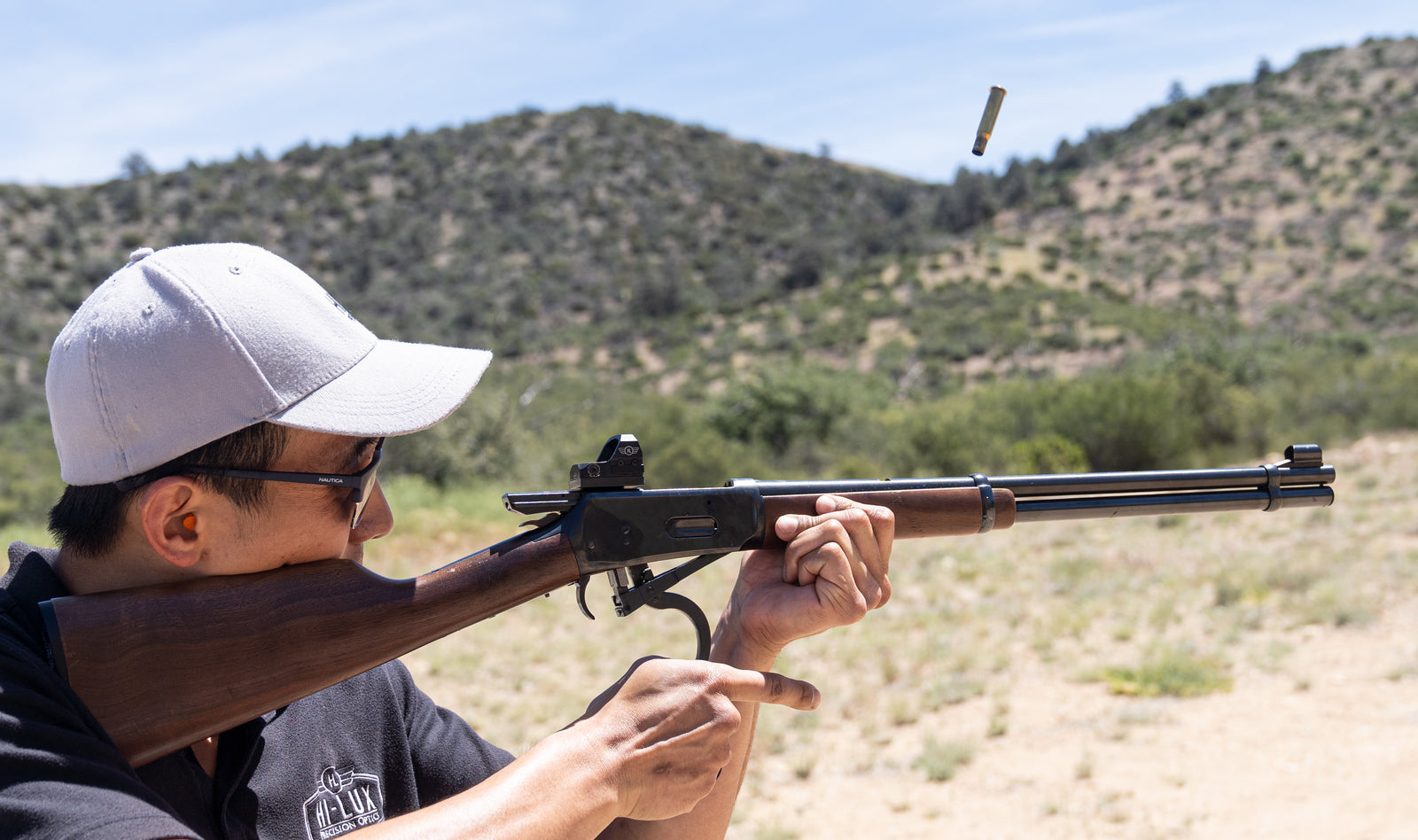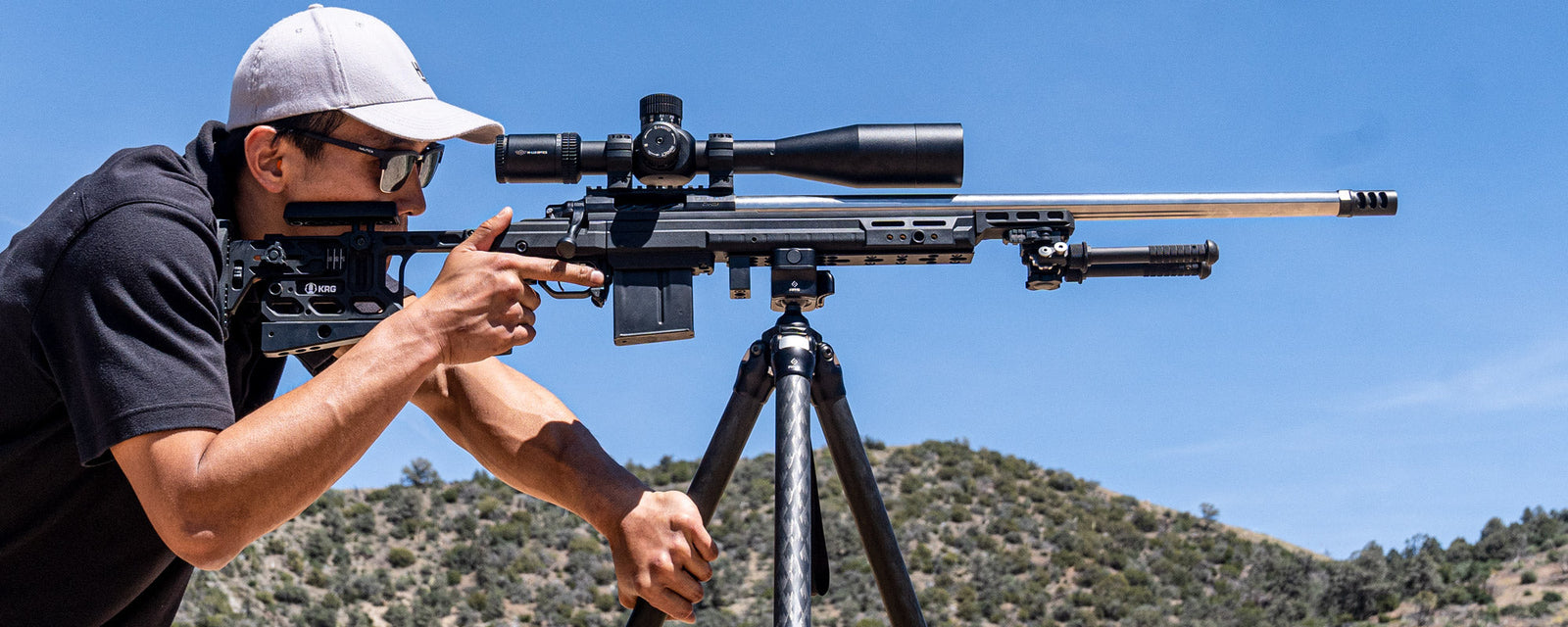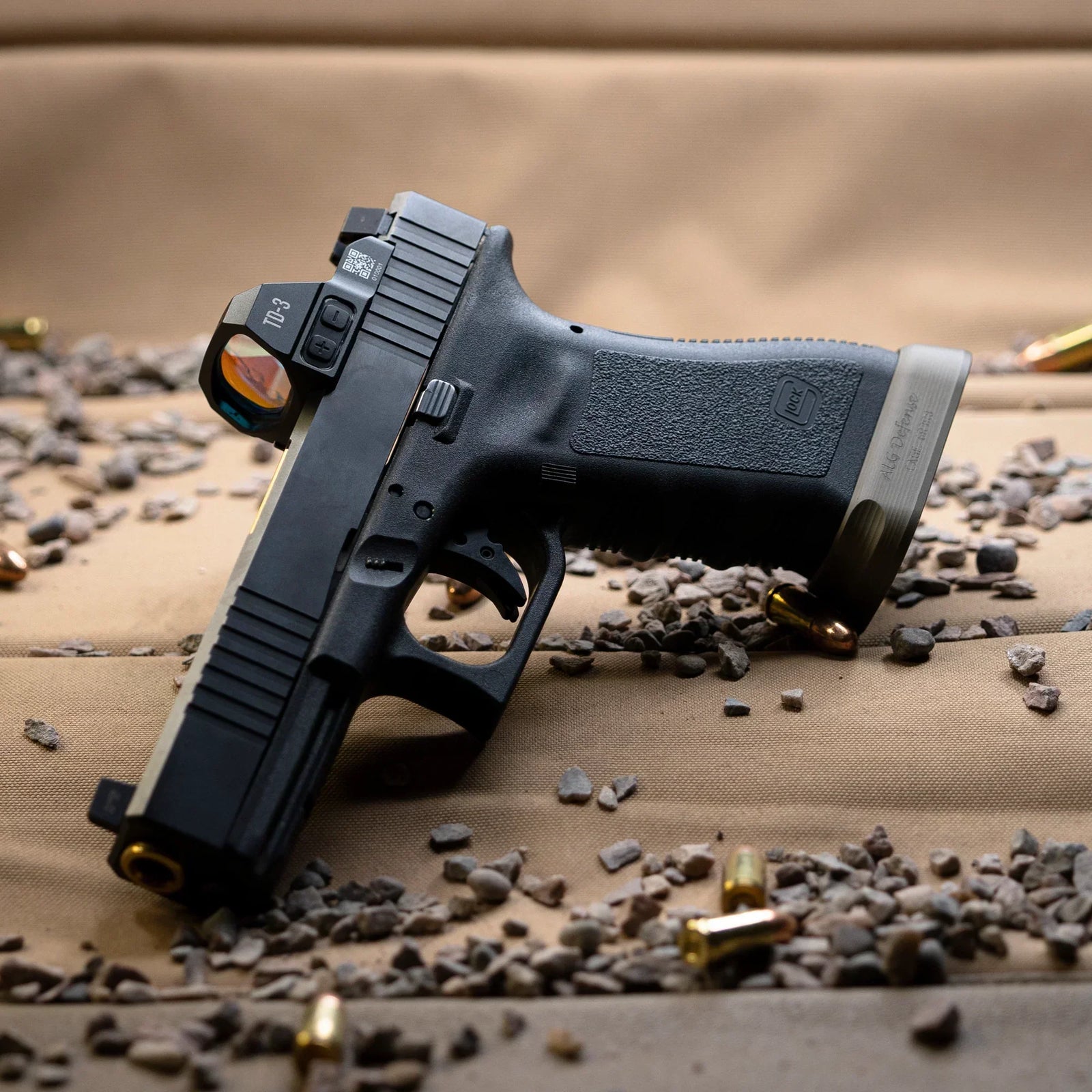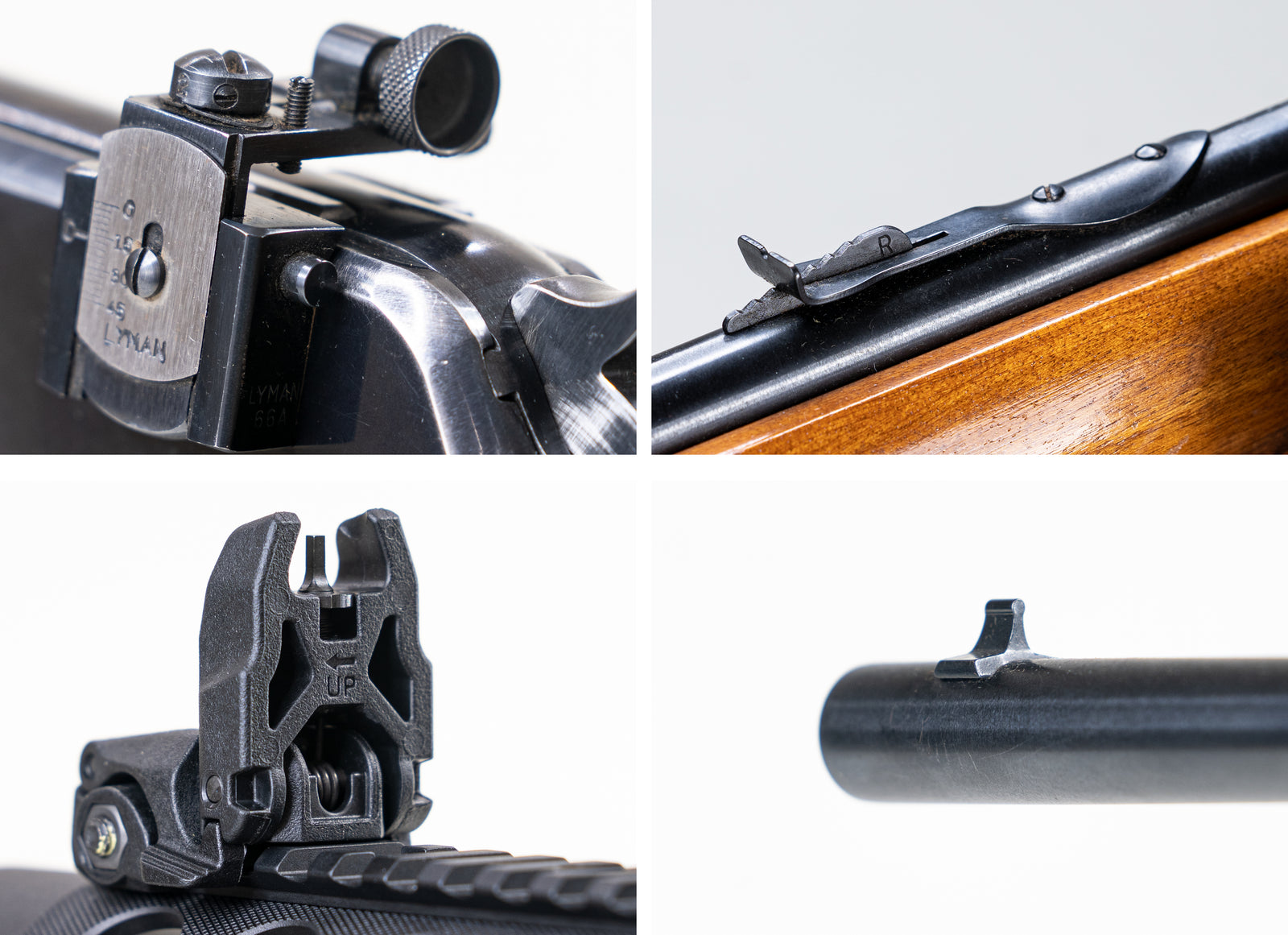A lever action rifle is built on a classic design, originating in the early 1800s with Rocket Ball Ammunition (if you want to read some wild stories…). In this rifle, the cocking action is performed by a loop down around the trigger area. This loop is moved out away from the receiver, retracting the internal bolt via some internal mechanical linkages. This same motion extracts the shell from the chamber on the pull back (and out), and then chambers the next round as the loop is retracted. This motion will also likely cock the hammer, though some older lever actions required a separate manual cocking of the hammer. Regardless, lever action rifles are among the few that have an external hammer.

A lever action rifle kept on target while loading the next round. These actions are remarkably quick when used properly.
Lever Action Magazines
Lever action rifles almost never have detachable magazines, though a few designs have been developed in history. Instead, they’re almost certain to have a tubular magazine down below the barrel. This magazine is often fed either at the muzzle end of the tubular magazine by removing a ramrod, through the receiver by use of a small side window, or down at the butt of the rifle through the opening of a rear plate.

The classic Henry H001 showing off its tubular magazine. In the first shot, the rifle is fully assembled. In the second, the ramrod has been removed and a line of rounds laid out below. In the third, a round can be seen through the loading window with the ramrod pushing against it.
Working the Loop
Due to the amount of room the loop needs to fully cycle the action, this sort of rifle never has much luck down by the ground or just over the bench. This has largely kept it out of military action, as prone soldiers have to raise the rifle from the ground in order to chamber the next round - losing time, losing the sight picture, and waving a flag at their location. In the precision rifle field, lever actions are generally not used on the bench or prone for the first two reasons (and not so much the latter).
That being said, a lever action rifle used in a standing position can be quite fast; the hand working the lever does not need to move far from the trigger to work the action. The hand can generally be left in the same position, except for the pulling of the trigger finger away from the trigger during the downward motion of the handle.

A lever action rifle held high above the table while the lever is fully descended. It requires a fair amount of vertical room to cycle the action.
Lever Action History
The
Winchester 1873 is among the most famous of lever action models, but the rifle actually got its start nearly 50 years earlier. In 1829, Cesar Rogelio patented his 1826 model of lever action repeater - firing off six rounds in six seconds. A few other designs followed this - the Volcanic being the most notable variation before the Spencer Repeating Rifle and Henry Repeating Rifle came into being in 1860.
The Spencer Rifle had a magazine in the buttstock. The United States adopted this rifle for its military during the Civil War, and was the first time a military used a rifle with a magazine. The lever action in this rifle did not cock the hammer, but merely unlocked the action and chambered a new round. The hammer would have to be actuated manually. The military was initially opposed to the adoption of this rifle, as some upper-level staff believed the magazine and easy loading would encourage the wasting of ammunition.
The Henry Rifle, released around the same time, had a tubular magazine beneath the barrel, which has since become the trend. This rifle also had the hammer cock when the bolt was moved back, another design that has been standard for lever actions since.
From then on, lever action rifles proliferated in design and implementation. Other famous producers of lever actions in history include Marlin, Winchester, and Savage, all of whom entered the field before 1900.

A Winchester 1873 with its side panel removed to show the internal workings. As the lever is lowered, the bolt moves back to cock the hammer. Simultaneously, the spent case is ejected. Upon closing the lever, the bolt moves forward to chamber a new round.
What Are Lever Actions Good For?
Lever actions are now commonly found in the Cowboy Action Shooting field, where the Single Action Shooting Society largely dominates. SASS competitions are lively events, each competitor running a vintage version of a 3-gun competition; Rifle, handgun, shotgun. All designs must be quite old, often nowadays being reproductions of vintage firearms. The dress code is (hopefully) strictly enforced, and an alias is encouraged. The lever action rifles are typically chambered in a pistol caliber, for safer close-distance shooting and lower recoil.
Historically, lever actions have also been chambered in pistol calibers to also allow interchangeability between the rifle and the six-shooter on your hip. If you’re looking at a lever action, it might benefit you to simultaneously plan ahead for any revolvers you’ll eventually get.
For long-range shooting, lever actions are rare to the point of nonexistence. They are commonly built to handle low-power cartridges, and thus have an inherent limit on range. Tuning the components of the action can also be difficult. As much fun as a lever-action rifle may be, I wouldn’t use one beyond 300 yards.
Lever Action Safety
Lever action rifles may employ modern safety mechanisms, but more commonly use safeties that interact with the hammer. One common safety mechanism is the half cock. To engage such a safety, the hammer is pulled back partway. Pulling the hammer back the full distance would cock the rifle, but stopping at the ‘half cock’ position will lock the hammer in place. Not all lever action rifles will use this mechanism, but lever actions are among the only rifles that can employ such a safety due to their exposed hammers.
Curiously, this is where the expression “running off half-cocked” comes from. When the hammer is only half-cocked, the rifle is unable to fire. If you’re hoping to fire a shot, you’ll find yourself pulling hopelessly at the trigger. When lever actions were used in warfare or gunfights, having the hammer half-cocked could be a serious detriment to your chances of survival. To fire, you’d have to fully cock the hammer - costing precious seconds.
The issue with such a safety mechanism lies in how difficult it is to notice. When you’re pulling the hammer back on a lever action, you’ll notice it click as it moves. Generally, the first click is the position of the half-cock safety, while the second click is the hammer being locked into a ready-to-fire position. When trying to engage the safety, you may accidentally not notice the first click and proceed on to the second click. Instead of being safe, the rifle is actually ready to fire. In regards to running off half-cocked, you may pull the hammer back and think it’s ready to fire, only to have the hammer stuck in the first-click ‘safe’ position.
A hammer-based safety mechanism can be difficult to verify by simply looking at the hammer. Always keep your rifle pointed in a safe direction. The best way to avoid an accident is to deny them the opportunity to happen.
Another way to render the rifle safe is to open the lever (and action) and leave it open. Anybody that looks at your rifle can see that the loop is fully descended and the bolt is away from the chamber. I trust an open action far more than a half-cocked hammer.





Leave a comment (all fields required)